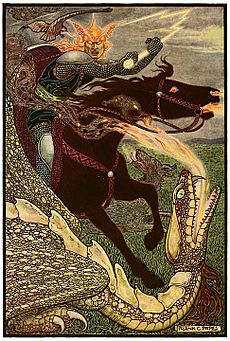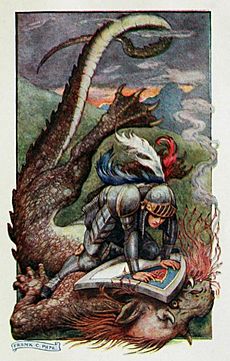Frank C. Papé facts for kids
Frank Cheyne Papé, who usually signed his name Frank C. Papé, was an English artist and book illustrator. He was born in Camberwell on July 4, 1878. He passed away in Bedford on May 5, 1972.
Papé studied art at The Slade School of Fine Art. He finished his studies around 1902–1904. He married Alice Stringer, who was also an illustrator and a fellow student from Slade.
Frank Papé's Artworks
Papé's first known artwork was for a book called Naughty Eric and Other Stories from Giant, Witch, and Fairyland. This book was published in 1902. It is very rare today.
His next illustrations appeared in children's books around 1908. These included The Toils and Travels of Odysseus, which was a translation of The Odyssey. He also illustrated The Pilgrim's Progress in 1910. In the 1910s, he drew many pictures for collections of fairy tales and folk stories.
By 1911, Papé was a very successful book illustrator. However, World War I began, and the market for illustrated books in Britain became much smaller. This affected Papé's work. He joined the Royal Army Service Corps in 1915. He served on the border between Greece and Bulgaria during the war.
Later Career and Success
Papé's career became successful again in the early 1920s. He illustrated several books by James Branch Cabell. These books made him famous in the United States. They were part of the Biography of the Life of Manuel series. Books like Jurgen, A Comedy of Justice (1921) and The High Place were published by The Bodley Head. Papé's drawings often matched the clever, hidden meanings in Cabell's stories.
Because these books were so popular, Bodley Head asked Papé to illustrate books by Anatole France. These included The Revolt of the Angels (1924) and Penguin Island (1925). He also illustrated works by Rabelais. Papé also designed book covers for other writers, such as Rafael Sabatini.
Around 1925, Papé started drawing for "Uncle Ray's Corner." This was a weekly children's newspaper column by Ramon Coffman. It was published in many newspapers across the United States. This partnership lasted for many years. It led to Papé illustrating books like Uncle Ray's Story of the Stone-Age People (1936) and The Child's Story of Science (1939).
Papé was also known for designing bookplates. These are special labels placed inside books to show who owns them. He designed one for the writer Dennis Wheatley. Papé also illustrated Wheatley's 1933 book about Charles II, called Old Rowley. He created the cover art for several of Wheatley's novels. These included The Devil Rides Out (1935) and To the Devil a Daughter (1953).
In the late 1930s, Papé's career slowed down. In 1945, he continued working with Ramon Coffman. Coffman started Uncle Ray's Magazine, and Papé contributed to it until the mid-1950s. He first worked as the art director, then as a staff artist.
By the end of the 1950s, Papé's eyesight was getting much worse. His only known work in the 1960s was a series of children's books for Oxford University Press. His very last published work was a 1968 reprint of his illustrated version of Robinson Crusoe from 1933.
Frank Papé's Legacy
Many of Frank Papé's original drawings are kept at Stanford University. Some of his letters are also preserved there.



